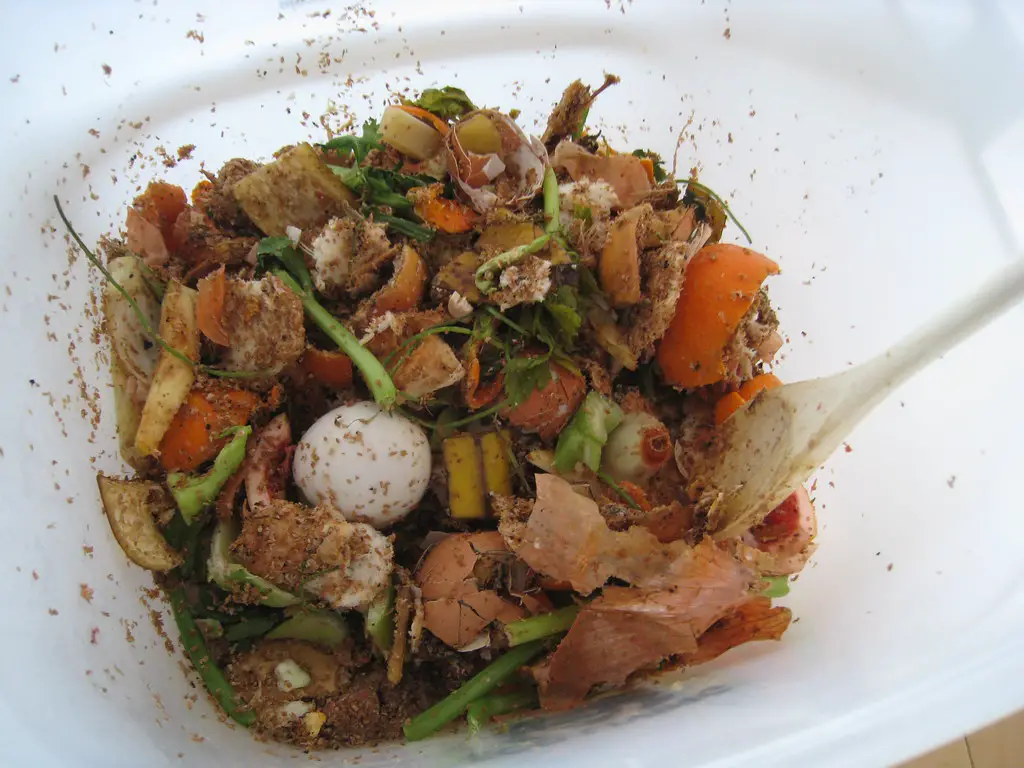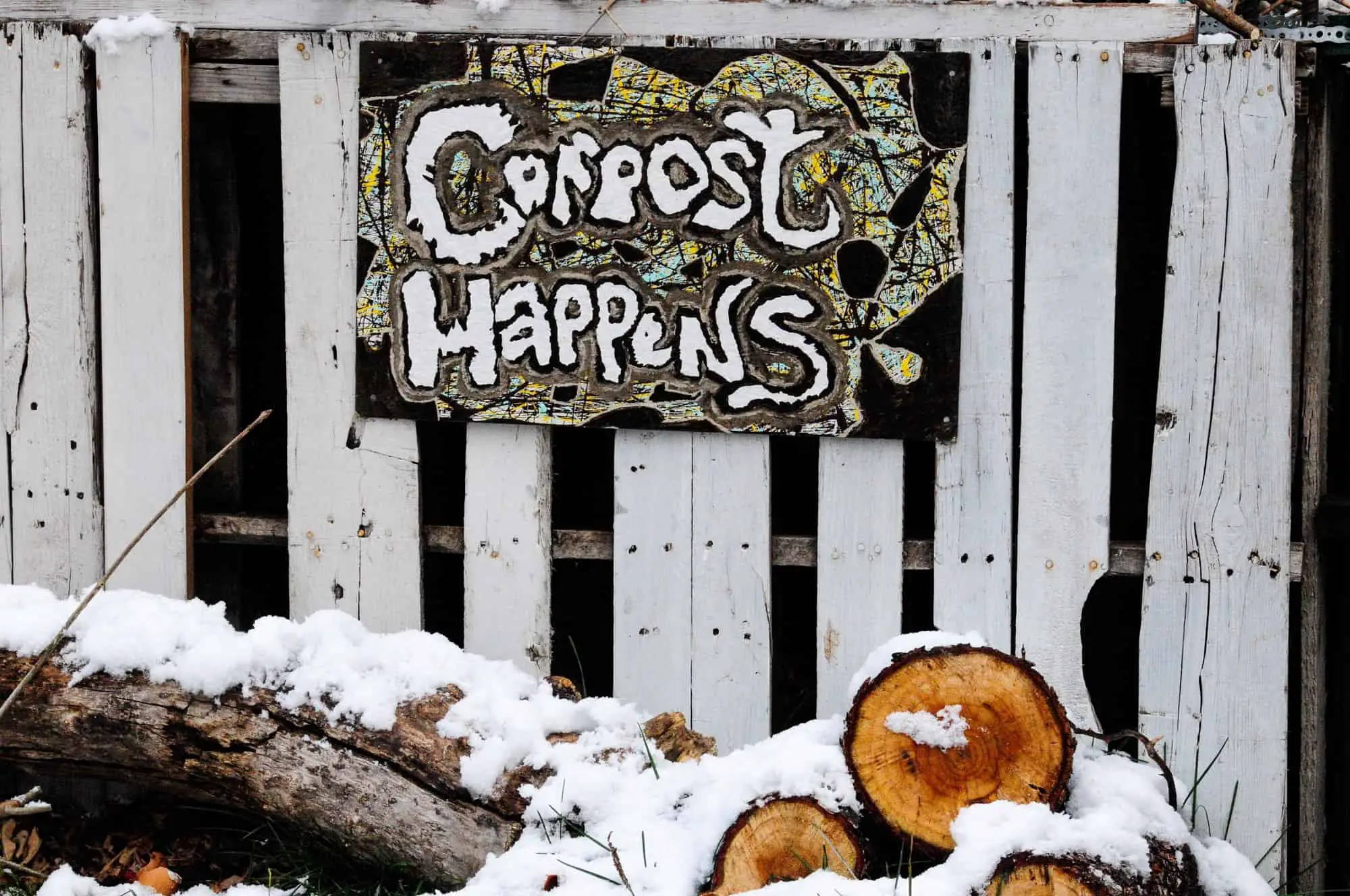Most people know that composting is good for the environment, and nearly every gardener know that compost is a fantastic soil amendment. However, I live in a small space, so it is not practical to start a compost pile on my patio. My neighbors certainly would not appreciate it. Luckily, there are several options available for people who want to start composting in a small space (click here to check out my article on composting in an apartment). Bokashi composting is a method frequently mentioned as a good option for people living in apartments or small spaces. I wanted to learn more about this process, so I did a little research.
Bokashi composting is an anaerobic process that ferments food scraps, including meat and dairy products, in a bran-based material that is inoculated with effective microorganisms (EM). The process typically takes about two weeks to complete. The final product is then buried in soil or added to a compost pile where it will break down rapidly. Unlike other composting methods, Bokashi composting does not generate greenhouse gases.
The remainder of this article will describe bokashi composting in detail and will help you decide whether this methodology makes sense for you and your lifestyle.
What is Bokashi Composting?
Bokashi is a Japanese word that means “fermented organic matter.” Bokashi composting is a process that involves pickling food scraps with the help of microbes often referred to as effective microorganisms (EM). This method is often used to pre-compost food scraps so that they will break down rapidly in a traditional compost bin/pile. However, Bokashi compost can be used in a variety of ways as I will discuss later.

The modern Bokashi composting method was developed by Dr. Teruo Higa, who is a professor emeritus at University of the Ryukyus in Okinawa and the director at the International EM Technology Center of Meio University in Okinawa, during the 1980s. Dr. Higa discovered the potential of effective microorganisms (EM) while studying mandarin oranges for his doctorate in Horticulture at Kyushyu University. He continued researching the potential of EM after he earned his doctorate and found the optimal mix for promoting plant growth in 1980. At that time, he coined the term EM.
A large group of microorganisms…photosynthetic bacteria, yeasts, lactic acid bacteria, and fungi are just some of the strains of antibiotic microorganisms belonging to the EM group. When a combination of them is present in the soil and they are proliferating in sufficient numbers, they bring about an increase in antioxidation levels and a resultant intensification of energy concentrations.
Dr. Teruo Higa, An Earth Saving Revolution
Today, EM is used for a variety of applications including gardening, cleaning, and even washing pets. EM-1, which is manufactured in over 50 countries under the supervision of ERMO, is a product commonly used to inoculate bran and rice products for Bokashi composting.
Bokashi Composting vs. Traditional Composting
The differences between Bokashi composting and traditional composting are outlined in the table below.
| Bokashi Composting | Traditional Composting |
|---|---|
| Anaerobic – occurs without the presence of oxygen. | Aerobic – occurs with the help of oxygen |
| Minimal greenhouse gas emissions. | Generates greenhouse gases such as methane, carbon dioxide, and nitrous oxide. |
| Pests are not a problem due to Bokashi composting being a closed system. | Traditional composting methods attract rodents and other pests. This may not be an issue if your compost pile is located far away from your home. |
| Newspaper is used to prevent clogging and filter water through food waste. | The ratio of browns to greens is crucial in order to ensure that the compost pile is aerated. |
| All food scraps can be added to a Bokashi compost bucket including meat, dairy, and cooked food containing oil. No lawn scraps should be added. | Fruit and vegetable scraps, grass clippings, twigs, wood chips, cardboard, and newspaper can be added to a traditional compost pile. Meat, dairy, and foods containing a lot of oil should not be added. |
| Inoculated bran or microbial spray required. | Does not require inoculated bran or microbial spray. |
| Produces finished compost in 30-45 days. | Produces finished compost in 2 months to 2 years. |
| No turning required. | Turning is important in to ensure that the organic waste is properly aerated. |
Bokashi Bin vs. Bokashi Bucket
There are two common Bokashi composting methods: the Bokashi bin and the Bokashi bucket.
The Bokashi bucket is probably the most widely practiced method. It involves fermenting your food waste in a sealed bucket or container before burying the finished product in soil or adding it to a compost pile.
Bokashi bin composting involves adding your food waste directly to a compost pile/bin and covering it with Bokashi bran. This process takes a little longer, and you cannot compost meat, dairy, or food scraps containing a lot of oil.
Does Bokashi compost smell?
Bokashi composting will not have much of a pungent odor as long as you add enough of the Bokashi grain.
If properly managed and set up, Bokashi compost smells like pickles. However, the acidic pickle smell can be quite strong and bother some people. If your system begins to smell really bad, you may need to drain some liquid from the bucket. This liquid is highly fermented and can actually be poured in your toilet or down another drain to unclog the pipes. After draining the liquid, add a little bit of sugar to you Bokashi bucket to activate/feed the microbes.
How To Build Your Own Bokashi Fermentation Vessel
Materials
- EM Bokashi (bran or grain inoculated with EM)
- Newspaper – prevents clogging and filters water/liquid fertilizer from the fermented food waste
- Wooden spoon
- Airtight bucket with a spigot at the bottom of the bucket
- Food waste
- A place to store your Bokashi Bucket at room temperature
Step 1 – Add the initial contents to the Bokashi Bucket
Put some newspaper at the bottom of the bucket and sprinkle a little EM Bokashi on top of the newspaper. Next, add your initial food waste and sprinkle some more EM Bokashi on top of the food waste.
Step 2 – Continue to add food waste
Continue to add food waste to your bucket. Every time you add food waste, sprinkle some EM Bokashi on top and squish the contents of the bucket down with a wooden spoon. This is important because Bokashi is an anaerobic process, and the “squishing” removes air pockets. You do not need to mix the contents of the bucket.
Step 3 – Drain juice from the bucket regularly
Drain the juice/liquid fertilizer from the Bokashi bucket regularly by using the spigot at the bottom of the bucket. Dilute the liquid fertilizer heavily (add 500-1,000 times more water than fertilizer) and use on your plants within 1-2 days as it goes sour quickly. Because this liquid is so acidic, you can also pour the juice into your toilet or sink to unclog drain pipes.
Step 4 – Leave the full bucket for at least one week
After the Bokashi bucket is full of food scraps, allow the contents of the bucket to ferment for at least one week. Keep the bucket covered and store it in a place that stays at room temperature.
Step 5 – Use the finished Bokashi compost
As previously mentioned, finished Bokashi compost is not really compost. It is fermented food scraps. Unlike compost, the contents of your bucket will be recognizable and not resemble potting soil. In order to complete the compost process, bury the fermented product or add it to your traditional compost bin. The following section provides a more detailed description of these options.
How To Use Bokashi Compost
So you’ve set up your Bokashi compost system. What do you do with the pickled food waster after the two-week fermentation time? There are actually several ways that you can use your Bokashi compost.
Bury The Bokashi Compost
After the two-week fermentation time, you can bury the pickled food waste in a hole or trench that is 8 to 12 inches deep. It is important to bury a hole that is deep enough. Otherwise, vermin will be attracted to the smell. Hens also like to dig up Bokashi compost.
Bokashi is very acidic, so make sure that it does not come into contact with plant roots until it has had enough time to neutralize (about 2 weeks). After allowing the fermented food waste to neutralize, plant seedlings or plants on top of the buried Bokashi compost.
Use The Bokashi Grain To Minimize Odors in Animal Pens
The anaerobes in Bokashi grain will feed on the wet animal manures in your chicken or pig pens. This will minimize the odors in your animal pen.
Add Bokashi Compost to Your Traditional Compost Pile or Bin
Bokashi compost will compost quickly in a traditional compost pile or bin because it helps raise the temperature of the pile. This means that you can produce more compost for your garden without having to wait for almost 2 years for everything to fully decompose.
Use Bokashi Bucket Juice to Fertilize Plants
As previously mentioned, you can use the liquid fertilizer obtained from the spigot of the Bokashi bucket to fertilize your plants. However, it is important to remember dilute this liquid heavily as it is very acidic. ERMO, which is the company that produces EM-1, recommends diluting Bokashi juice 500-1,000 times with water.
Benefits of Bokashi Compost to Plant Growth
Adding Bokashi compost to your garden not only reduces the amount of waste that goes to landfills, it also improves the health of your garden. There is a growing body of evidence that shows that using compost derived from Bokashi significantly improves plant growth.
A study conducted by Dr. Prisa at the CREA Research Centre for Vegetable and Ornamental Crops in Italy found that adding Bokashi to growing medium significant improved the growth of Kalanchoe blossfeldiana, which is long-flowering succulent that belongs to the Crassulaceae family. Plants treated with Bokashi also had a higher chlorophyll content and used water more efficiently (Prisa, 2020).
The results of another study indicate that Bokashi treatment improved the dry yield and oil recovery of Patchouli (Zamen et al., 2009).
However, another research study conducted at the University of Florida found that the EM in compost derived from fermented Bokashi did not prevent soil-borne diseases or impact microbial activity (Shin et al., 2017).
Can you use bokashi to compost pet waste?
There are Bokashi fermentation systems that safely convert pet waste into a product that can be used on ornamental plants. However, compost made from pet waste should never be used on food crops as it may contain harmful pathogens.
Learn More About Bokashi Composting
To learn more about bokashi composting, I recommend reading Adam Footer’s book entitled Bokashi Composting: Scraps to Soil in Weeks. It is an easy read, explains the science of bokashi composting in detail, and clearly outlines how to compost your kitchen scraps with Bokashi.

